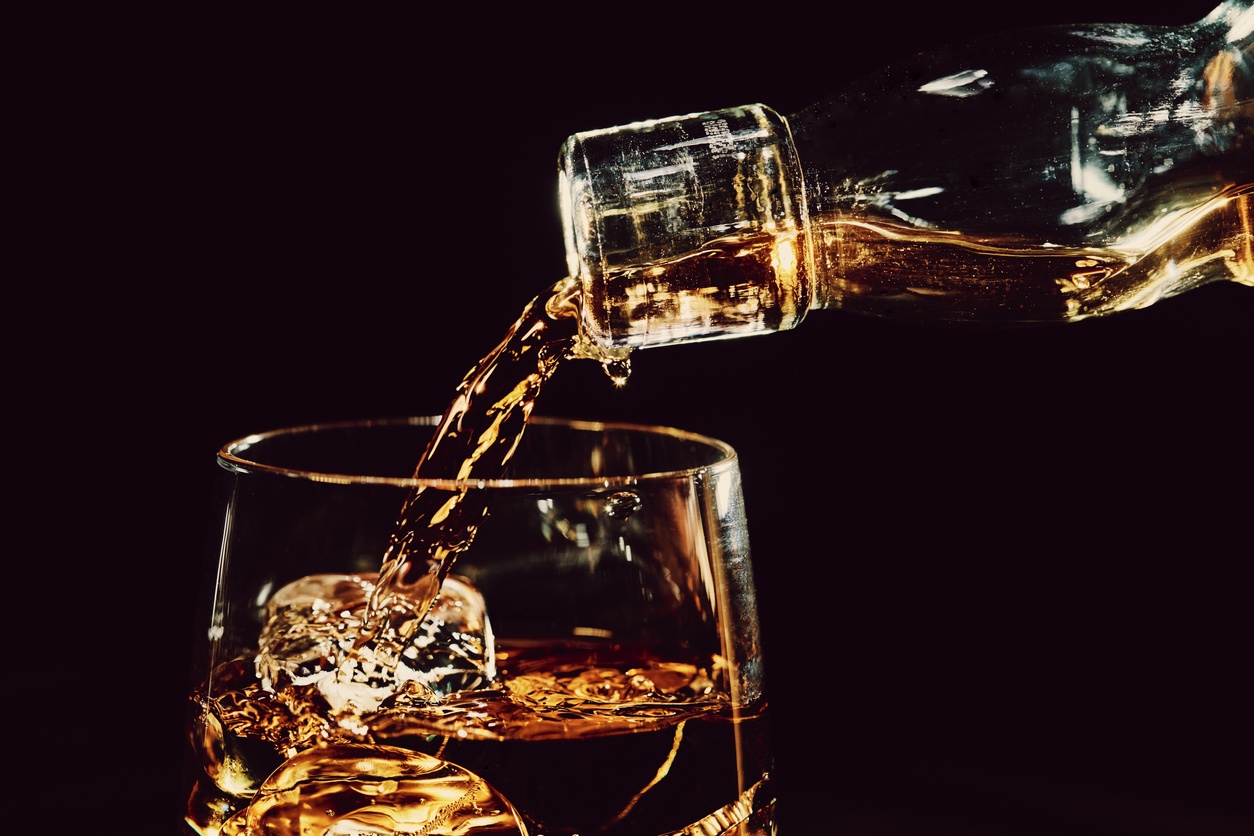Whiskey Business
The origins of whiskey can be traced all the way back to the Dark Ages in Ireland and Scotland; according to legend, monks unable to grow grapes for wine began fermenting grains instead. Their experiments eventually resulted in the advent of aquae vitae, a distilled, grain-based liquor that resisted spoiling and packed a powerful wallop of alcohol. Over time, Ireland and Scotland developed distinct whiskey (or “whisky” in Scotland) traditions that have continued to the present day – you can learn more about those traditions HERE. As for whiskey in America, emigrating colonists brought whiskey and the knowledge to distill it with them over to the New World. As the colonies prospered and grain became abundant, informal stills began to crop up across the countryside, with individuals producing only enough whiskey for themselves and their neighbors from leftover grain stores. With time and a little help from old pal George Washington, whiskey production eventually transitioned from a side-hustle to a bonafide cottage industry, but the evolution of American whiskey wasn’t over yet.
Over the course of the 1700’s, migrants from Scotland, Ireland, and even Germany poured into the American colonies, but they didn’t often linger where they had arrived for long. Many German and Scottish immigrants settled in the areas of Pennsylvania and Maryland, and using rye transplanted from home in place of less-hardy barley, they began to produce distinctive rye whiskies. At the same, the western frontier in Kentucky had been calling to immigrants, offering tempting “corn patch and cabin rights” to incentivize settlers; with land already cheap and plentiful, people moved in droves to establish homesteads in Kentucky. The subsequent abundance of corn combined with Kentucky’s distinctive, limestone-enriched waters made it prime territory for whiskey-making, and distilleries once again began to dot the countryside.
Now, we mentioned before that whiskey had become industrialized to an extent, but there was virtually no regulation, and the majority of distillers were still trading their product directly for goods and services. As a result, most distillers did not have a great deal of monetary wealth, even if they were able to live well off the production of their wares. In 1791, George Washington approved an excise tax on both imported and domestic liquor as a way to help offset the debt accrued during the Revolutionary War. Unable to pay and unwilling to travel through the wild countryside to Philadelphia to protest, Pennsylvania distillers revolted, and from 1791 to 1794, The Whiskey Rebellion sought to resist the tax through any means necessary.
By the end of the Whiskey Rebellion, many Pennsylvania farmers associated with the revolt had fled to the newly-minted state of Kentucky, where they encountered established corn whiskey-makers and their methods. At some point, Pennsylvania and Kentucky traditions merged to create whiskey styles that were completely new and as uniquely American as their creators. Initially, what we would call Bourbon was known as “Kentucky” or “Western” whiskey after its place of origin and to distinguish it from the incoming Pennsylvania and Maryland styles. At the time, good barrels for storing the whiskey were hard to come by, and the best would be reused and recycled; to remove any leftover smells or dirt, the barrels would be burnt before reuse, lending a distinctive flavor to any whiskey stored within. Whiskey was also not aged and therefore didn’t take on the classic amber color nor the complex flavor. Indeed, it wasn’t until whiskey was being traded along the Mississippi that whiskey-makers began to realize the value in aging whiskey. By the 1840’s, some clever someone had put two-and-two together, and the institution of Bourbon whiskey was born!
Of course, this isn’t even half the story – to continue down the Bourbon rabbit hole, check out this article by American Whiskey Trail!
Whiskey A-Go-Go
These days, in order to be officially considered Bourbon whiskey, a product has to meet the following criteria: it must be at least 51% corn, have a max ABV of 80%, and have been aged at least 2 years in charred oak barrels. Whiskies from the same batch but different barrels are often blended to highlight specific nuances in flavor and maintain consistency in the finished product, but if a particular group of barrels are chosen to create a very specific blend, then the whiskey is known as small-batch. Alternatively, single-barrel whiskey is Bourbon purposefully selected from a single barrel and is virtually impossible to replicate. These kinds of masterful blends are a far cry from cheap blended whiskey, which by definition only needs to consist of 20% real whiskey and is usually spiked with higher-ABV neutral spirits.
There are several ways to enjoy whiskey, and each brings out different characteristics. Using a combination of methods allows you to appreciate the range of subtleties in a good Bourbon, allowing you to have different experiences of the same whiskey. They are as follows:
- Neat – Served straight-up without water or ice, a whiskey neat is an easy way to enjoy the true essence of any whiskey. Use a Glencairn glass or Whiskey Snifter to best appreciate the intense nose and bold flavor.
- With Water – While diluting good Bourbon might seem like a cardinal sin, it’s actually one of the best ways to experience the full range of flavor. Water cuts through the alcohol and releases certain aromatics which otherwise might be lost to the glass. Simply add a dash or two of water to a Glencairn glass or Whiskey Snifter and stir into your whiskey.
- On the Rocks – A Bourbon on the rocks is certainly the classiest way to order whiskey, but it’s arguably not the best way to serve it since the ice numbs your palate. That being said, if a cold whiskey is your preference, then opt for a single, large ice cube or ice sphere. This will keep your whiskey cold without diluting it too rapidly, as will serving it in a thick-bottomed Rocks Glass.
- In a Cocktail – Adding your favorite whiskey to a cocktail is a great way to enhance the flavors you love while hiding the flavors you don’t. Choose whiskies with a strong flavor (like rye) or with a high alcohol percentage to stand up to the other ingredients in popular whiskey cocktails – click HERE for recipes to get started!
Even with the official standards in place, every Bourbon and rye whiskey is going to be unique to the distillery, the batch, the blend and especially the barrel, so don’t be afraid to try a single whiskey several different ways. With higher-end, small-batch or single barrel whiskies, opt for more simple preparations to showcase the depth and complexity of the product itself. Also, whiskey is a strong product – if a whiskey neat is more than you can handle, there’s no shame is adding some water or mixing it into a cocktail! After all, the more the delicious the whiskey, the more delicious the drinks you make with it.
This week, give Dad the Father’s Day gift that’s a true American original with specially selected whiskies from Oliver’s! These delicious whiskies (and one cognac) are a real cross-section of American whiskey, and with everything from true-blue Kentucky Bourbon to craft-distilled California originals, you’re sure to find the perfect gift for even the pickiest Dad. Check them out below!
Bulleit Bourbon
Bulleit Bourbon is inspired by the whiskey pioneered by Augustus Bulleit over 150 years ago. Only ingredients of the very highest quality are used. The subtlety and complexity of Bulleit Bourbon come from its unique blend of rye, corn, and barley malt, along with special strains of yeast and pure Kentucky limestone filtered water. Due to its especially high rye content, Bulleit Bourbon has a bold, spicy character with a finish that’s distinctively clean and smooth.
Redwood Empire Pipe Dream
Named for the 14th tallest tree on the planet, Pipe Dream is this distiller’s first Bourbon whiskey. Pipe Dream Bourbon is made from barrels aged between four and twelve years with a high corn mash bill. Smooth and complex, it is a true sipping whiskey.
Redwood Empire Lost Monarch
Named after the world’s largest coastal Redwood, Lost Monarch whiskey has a name to live up to. An award-winning bourbon-rye blend with an exceptional balance of sweetness and spice. The perfect choice for those who just can’t decide between rye or bourbon, it can be considered “the best of both worlds.”
Redwood Empire Emerald Giant
Named after the fastest growing Redwood in the world, Emerald Giant is a fan favorite in the Rye world. It begins with a mash-bill of 95% premium rye and is aged for over 3 years in new charred oak barrels. Spicy with an exceptionally smooth finish, it is a great choice in any classic whiskey cocktail.
Knob Creek Bourbon
A benchmark in bourbon. Patiently-aged in white oak barrels for nine years, and bottled at 100 proof.
Knob Creek Rye
The world’s best rye for the world’s best cocktails. Aroma of herbs, rye, and oak gives way to spicy rye and oak on the palate.
Knob Creek Maple
Naturally sweet and smoky maple fortified by charred oak bourbon.
Camus VS Elegance Cognac
Elegance is the defining characteristic of all Camus Cognacs. Camus VS Elegance is a careful blend of eaux-de-vie made from wines distilled without lees. Its personality is very faithful to the original aromas of the wine and the quintessential flavors of the Charente terroir, characterized by delicate fruity and floral notes.
Four Roses Straight Bourbon
You’ll want to savor the taste of this premium Bourbon again and again. It’s complex, full-bodied and surprisingly smooth with a delicate, long finish that’s unbelievably mellow. Enjoy straight up or on the rocks.
Elijah Craig Small Batch Bourbon Whiskey
Expertly aged in Level 3 charred oak barrels, this award-winning Small Batch Bourbon is known for its signature warm spice & subtle smoke flavors. Each barrel is hand selected by their Master Distillers.
Jack Daniel’s Tennessee Whiskey
This Tennessee Whiskey doesn’t follow a calendar. It’s only ready when their tasters say it is. They judge it by the way it looks. By its aroma. And of course, by the way it tastes. It’s how Jack Daniel himself did it over a century ago. And how they still do it today.


No comments yet. Add the first comment